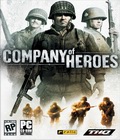Genre: Real-Time Strategy
Publisher: THQ
Developer: Relic Entertainment
Release Date: September 19, 2006
What Would a 30-Ton Tank Do?
The conventions of World War II-themed games have become so persistent and commonplace that the act of discerning cliché from authenticity is a grand struggle in its own right. Everyman heroes, squadmate drama, clear distinctions between good and evil that let you enjoy the shooting without much regard for the corpses piling up, forever referencing the first 20 minutes of Saving Private Ryan – it's all endlessly recombined to balance the intensity-versus-authenticity equation in new ways that keep gamers coming back for more. For anyone who's not so enamored of the setting itself that the mere mention of Allies and Axis is enough to stir some interest, it takes a great deal of genuine excitement to escape the wash of empty hype promoting the same old greatest-generation drama.
Relic Entertainment's approach to breaking through with their upcoming PC real-time strategy game Company of Heroes, as summed up by developers on hand at the THQ pre-E3 summit, was to consider what problems bug them most about RTS titles and get to fixing them. Two big ones leapt to the forefront – units that behave stupidly and environments that are pretty but don't really matter much in terms of gameplay. Given the quality of the event's preview build, it looks like Company of Heroes has solutions for those frequent flies in the RTS ointment. It also promises to be approachable without sacrificing depth, hoping to deliver a good-looking, satisfying experience that's figure-outable in a scant 15-minute learning curve.
The story is a classic World War II setup, following Able Company through the invasion of Normandy and deeper into the European theater in the single-player campaign. Airborne assault, infantry and armor units bring the firepower in the form of paratroopers, flamethrowers, tanks, guys with seriously powerful satchel charges and artillery to soften up enemy positions and remove cover before you send in your direct-combat units. The command interface looks clean and already seems to achieve the approachability goal, making it easy to manage your troops without foregoing possibilities in the name of mass appeal.
The most impressive aspect of the demo wasn't so much the types or varieties of units – nothing wrong with what's there, though, mind you – but rather how those units behave when you issue orders. When you order infantry to proceed from a rally point and reassemble behind a nearby building, they seek cover on their own from nearby hedgerows instead of streaming dumbly toward their destination regardless of how exposed they are along the way. When you blast holes in village houses, your soldiers make use of the newly formed opportunities for cover, actually seeming to know where the new holes in the buildings are. The goal, say the developers, is to create a sense of commanding real units that would seek the safest path toward a waypoint because they know they'd bite it otherwise, whether they're on foot or in armor. Or, as one developer put it, "a 30-ton tank should do 30-ton tank kind of stuff."
The environments themselves appear to be holding up their end of the bargain as far as putting that AI to work goes. Battlefield structures are built of discrete panels that allow for 249 possible ways of tearing things down, say the devs. Everything on the battlefield has its own properties, which means it can all be destroyed and alter the nature of the fighting on the fly, opening new paths to flank enemy units, for example, or letting you destroy walls to surprise opposing forces while they're occupied by an attack coming from another direction. When coupled with your units' smarts, the evolving battlefield conditions hint at some serious replayability in the single-player campaign as you find new ways to approach the same combat goals.
Bringing this to bear in combat looks promising from a big-picture standpoint as well as a unit-to-unit point of view. Scenarios are broken up into territories with resource points you must capture to produce resources at a greater rate and, in turn, build new units. In a nod toward focusing on strategy and combat over resource worries, the challenge in Company of Heroes isn't so much to micromanage the production of raw materials as it is to maintain a solid supply line all the way out to the front and maintain your units' war-fighting capabilities. Holding your supply lines looks to be a significant factor in the game's action, as you're always vulnerable to airborne assault troops who can drop in and secure a position without fighting their way directly through all the territory under your control. Beyond the single-player campaign, Company of Heroes supports LAN and online matches. Multiplayer modes will include Annihilation and Victory and support up to eight combatants.
Even though the focus is on the environmental impact on gameplay, it doesn't look like decoration will lose out in Company of Heroes. The demo build already sported an immersive polish, with green smoke effects marking paratrooper drop zones that drift smoothly across battlefields cratered from artillery blasts, rippling flags and stone houses with convincingly dilapidated roofs. Animations stand out, too, as infantry change their posture when hustling from exposed territory, assuming a lower profile as they slink through craters and alongside rock walls.
Ambitions of accessibility are always worrisome before a title hits the streets, as it's difficult to tell ahead of time to what extent "accessibility" means "dumbed down." It's a particularly troubling problem for fans of RTS and other genres that depend on complex command-and-control operations to appeal to their core fan base. In the case of Company of Heroes, as it stands right now, those kinds of worries seem to be for naught. Even if the lack of emphasis on resource management doesn't satisfy rivet-counting realists, the winning combination of strong unit AI and complex environment interaction promises to create opportunities for wily combat tactics in single-player and multiplayer matches alike. Relic staff likened the Company of Heroes experience to that of a "changing chessboard." RTS fans will be able to judge for themselves this fall.
More articles about Company of Heroes











 Company of Heroes delivers the World War II real-time strategy classic and both its expansions in one battle-hardened bundle.
Company of Heroes delivers the World War II real-time strategy classic and both its expansions in one battle-hardened bundle.


























